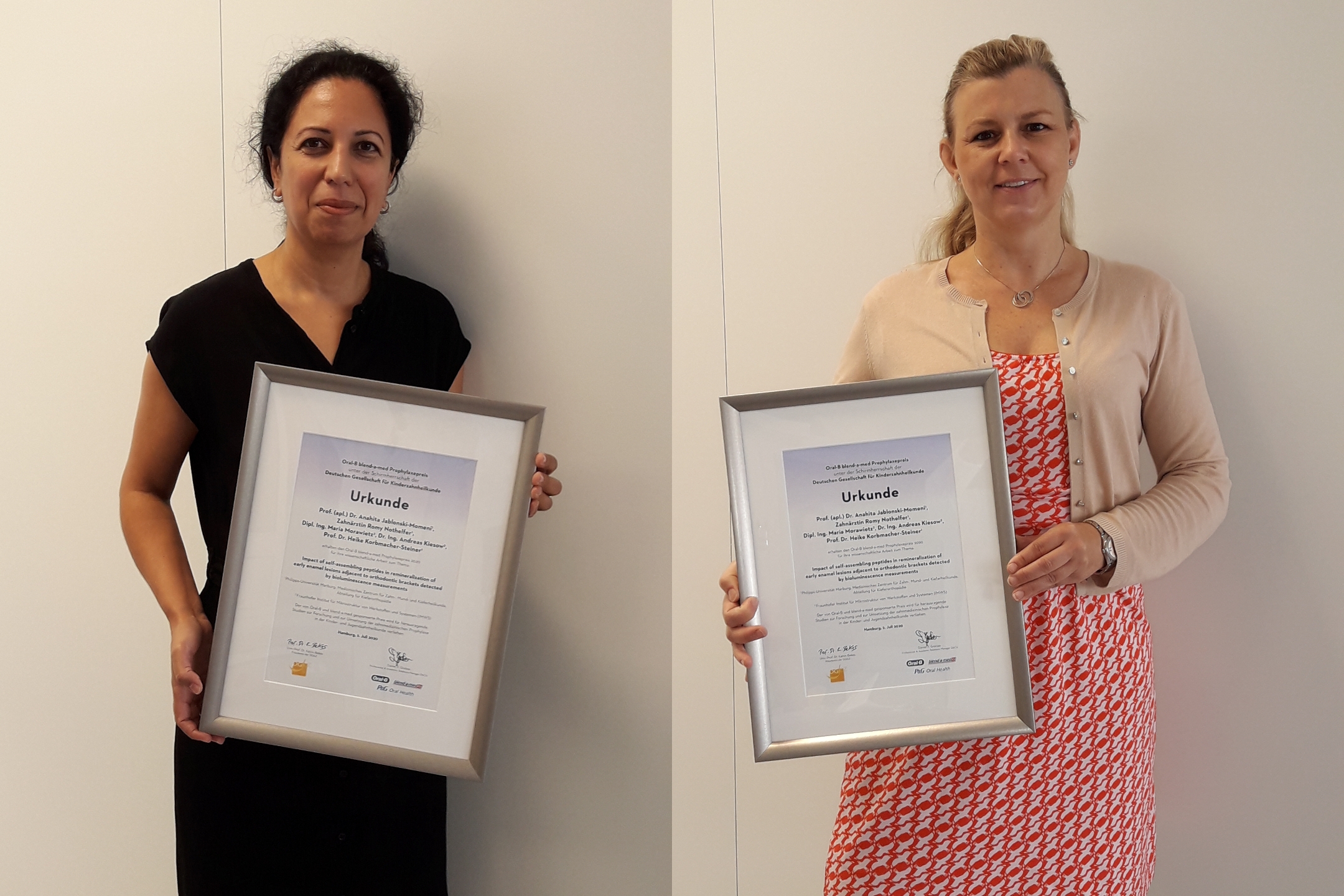Self-organizing peptide is proven to strengthen dental enamel: Award for University of Marburg and Fraunhofer IMWS
Wearing fixed braces can cause enamel to demineralize more around the edges of the teeth, which can be a source of caries. This effect can be counteracted with a combination of the peptide P11-4 and fluoride, as shown in a study by the Philipps University of Marburg and the Fraunhofer Institute for Microstructure of Materials and Systems (IMWS), which demonstrated the efficiency of this combination. The research results were awarded the Oral-B Award for Pediatric Dentistry and Prevention 2020.


When fixed braces are used for orthodontic treatment, the enamel may demineralize, especially at the edges of the surfaces where the braces are attached to the tooth. Such damage, which occurs with fixed braces in almost half of all cases, can lead to the formation of caries. Even the slightest damage to the enamel can cause bacteria to settle, multiply and penetrate further into the tooth.
If the defects are still at an early stage (initial lesion), a novel treatment method can stop the process and even help the tooth to repair itself: the use of the peptide P11-4. It is one of the self-organizing peptides that form a biological matrix. The peptide is applied to the tooth as a liquid, fills the lesion and ensures that calcium ions and other minerals are deposited in the tooth structure. In this way, the enamel is remineralized.
In their joint study, researchers from the Philipps University of Marburg and the Fraunhofer IMWS examined the remineralization effects that can be achieved in combination with fluorides. To this end, orthodontic braces were attached to enamel samples and initial lesions
created. A portion of the samples were then not treated at all, another portion only with a fluoride varnish, the third group with the peptide P11-4 and fluoride varnish. The samples were then kept in artificial saliva for a period of 90 days. “By using P11-4 in combination with a fluoride varnish, we were able to observe a significantly improved remineralization compared to the use of fluorides alone,” Prof. Anahita Jablonski-Momeni of the Philipps University of Marburg summarizes the results of the study.
“The colleagues in Marburg employed a novel bioluminescence method which detects free calcium ions that are present on the enamel surface during demineralization processes and digitally images them as luminescence areas. This method has turned out to be very powerful,” says Maria Morawietz from the Fraunhofer IMWS, which supported the study with supplementary microstructure analyses. The samples in the three groups were then examined after 7, 30 and 90 days respectively with Bioluminescence and Quantitative Light Induced Fluorescence (QLF) measurement.
The results of this joint project were awarded the “Oral-B blend-a-med Prophylaxis Prize under the patronage of the German Society of Pediatric Dentistry (DGKiZ)” as an outstanding contribution to research and implementation of dental prophylaxis in pediatric and adolescent dentistry. The prize winners are Prof. (apl.) Anahita Jablonski-Momeni, dentist Romy Nothelfer and Prof. Heike Korbmacher-Steiner from the Medical Center for Dentistry, Oral and Maxillofacial Surgery, Department of Orthodontics, Philipps University Marburg as well as Dipl.-lng. Maria Morawietz and Dr.-lng. Andreas Kiesow of the Fraunhofer IMWS.
“We are very pleased with this award for our collaboration,” says Dr. Jablonski-Momeni. “The award is a confirmation that major success can be achieved in pediatric and adolescent dentistry with new prevention concepts, especially for high-risk groups such as wearers of fixed orthodontic devices.” Partial results of the study have been published under the title “Impact of self-assembling peptides in remineralization of artificial early enamel lesions adjacent to orthodontic braces” as an open access publication in the high-ranking journal “Scientific Reports” published by Springer Nature Verlag (https://rdcu.be/b7eeV). A summary of the work will be published in the current issue of the journal “Oralprophylaxis & Pediatric Dentistry”.
Photo brackets. The image may be used free of charge for editorial purposes for reporting on this topic. Use for other purposes is only permitted with the prior consent of the Fraunhofer IMWS. [ JPG 0.35 MB ]
Photo certificates. The image may be used free of charge for editorial purposes for reporting on this topic. Use for other purposes is only permitted with the prior consent of the Fraunhofer IMWS. [ JPG 1.73 MB ]